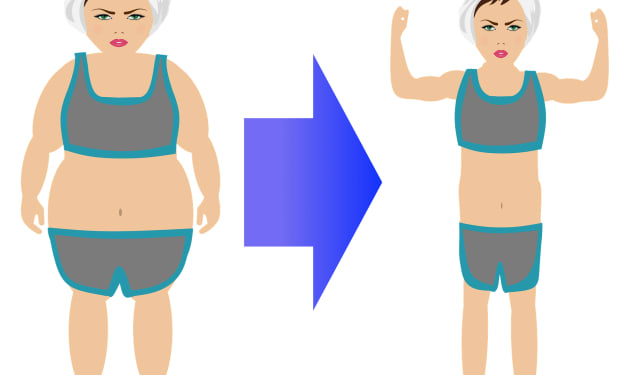This 1-Week, 16:8 Fasting Plan Will Help You Lose Weight Quickly
Struggling to lose weight? Use this 16:8 diet rule to see positive results.

Discontinuous fasting, or the act of fasting for a set period, has upset the conventional three-suppers daily mentality and changed the manner in which we consider eating times.
It is as of now quite possibly the most well-known wellbeing pattern, with the 16:8 eating routine being among the most widely recognized.
Individuals are receiving discontinuous fasting rehearses as a procedure to get more fit, improve mind work, and work on their dietary patterns and supper plans.
In any case, what is the 16:8 discontinuous fasting diet, and how would you begin?
What Is 16:8 Fasting?
Discontinuous fasting is a dietary example that shifts back and forth between times of fasting and eating.
In contrast to different eating regimens, fasting plans don't determine what or the amount you ought to eat each day.
All things considered, they essentially center around when you ought to eat.
Because of this differentiation, discontinuous fasting isn't viewed as an eating routine in the regular sense.
All things being equal, it very well might be better depicted as an eating design.
The 16:8 eating routine is a well-known variant of discontinuous fasting.
It includes devouring your dinners during an 8-hour eating window while fasting or going without nourishment for the leftover 16 hours every day.
How to Do It
The 16:8 discontinuous fasting technique, once in a while alluded to as the 16 hours quick, limits your eating to eight hours.
This type of discontinuous fasting is especially mainstream since you spend an enormous part of the fasting window snoozing.
To begin, start by choosing the eight hours during which you will devour the entirety of your dinners and bites.
Numerous individuals like to eat in the early afternoon and eight o'clock in the evening, as this implies that they just need to skip breakfast, while as yet having a normal lunch and supper.
Some eating windows include:
- 10 am to 6 pm
- 11 am to 7 pm
- 12 pm to 8 pm
When fostering your 16:8 arrangement, you might need to utilize your present rest examples and eating times as a guide.
For instance, on the off chance that you are an ambitious person, you may decide to break your fast around 10 am to keep away from abundant hours without food admission.
Or then again maybe your hunger is the best around evening time before bed. If so, then, at that point you may settle on a 1 pm to 9 pm window to take into consideration an evening nibble.
Sample 16:8 Fasting Schedule
- 7:00 am Wake up
- 7:30 am Lemon water
- 7:45 am Skip your morning meal
- 12:00 pm Lunch
- 3:00 pm Snack
- 6:00 pm Dinner
- 7:30 pm Snack
- 8:00 pm Begin fast for 16 hours.
Foods to Eat
In contrast to most eating regimens, 16:8 irregular fasting doesn't have any food rules or limitations.
There is no calorie limitation, implying that you don't sit around idly calorie-checking or observing your admission of carbs.
Thus, numerous individuals find that it works on their dietary patterns and permits them to invest less energy in supper arranging.
Notwithstanding, it is as yet prescribed to restrict the admission of handled and lousy nourishments, as these are related to weight acquire and an expanded danger of infections like heftiness, coronary illness, and particular sorts of malignancy.
Indeed, even while discontinuous fasting, attempt to zero in on quality food decisions which include:
- Fruits and vegetables
- Entire grains and complex carbs: Such as earthy colored rice, oats, grain, qui noa, and that's just the beginning
- Lean proteins: Lean red meat, poultry, fish, beans, tofu, nuts, seeds, and eggs
- Solid fats: From greasy fish, olive oil, avocados, coconuts, nuts, and seeds
The 16:8 eating regimen considers without calorie drinks during the 16-hour fasting period. These incorporate water, unsweetened teas, and dark espresso.
As well as forestalling lack of hydration, refreshments may likewise assume a pivotal part in diminishing craving prompts.
Drinking a lot of liquids may help increment sensations of satiety, implying that you will feel more full for more (1).
Benefits
16:8 discontinuous fasting is related with various medical advantages, including:
Weight Loss and Difference in Body Composition
The 16:8 eating regimen has become a supported health improvement plan among weight watchers, and for a valid justification.
There is proof that discontinuous fasting may assist you with getting thinner and lift your digestion (2, 3). It does this twoly:
To start with, fasting causes you to eat fewer dinners, bringing about diminished calorie admission and food utilization.
As a rule, people rehearsing the 16:8 quickly skip breakfast and quit eating at a set time.
Consequently, except if you overcompensate by eating considerably more during dinners, you wind up devouring less calories during the restricted 8-hour time period.
Furthermore, your body likewise changes chemical levels during a quick to make fat stores more available (2-6).
Essentially, when your body is cut off from its favored wellsprings of energy, in particular glucose and glycogen saves, it will adjust to begin consuming fat as its essential wellspring of fuel.
This implies that you are losing pounds, however, a segment of that weight reduction will come from muscle to fat ratio stockpiling.
What amount of weight would you be able to hope to lose on an irregular quick?
As indicated by a 2014 audit article, irregular fasting was found to diminish body weight by 3 to 8% more than 3 to 24 weeks.
This investigation likewise discovered that members had a 4 to 7% decrease in midriff outline, implying that they lost tummy fat (7).
An alternate survey study tracked down that discontinuous fasting may cause a weight reduction of 11 to 16% following 12 weeks.
Moreover, specialists noticed that irregular fasting brought about a lower loss of muscle tissue when contrasted with common calorie limitation eats fewer carbs (8).
Decreased Risk of Type 2 Diabetes
Type 2 diabetes creates, to some degree, because of insulin obstruction. Insulin is a chemical that advises the cells of your body to retain and utilize glucose for energy.
In individuals with insulin obstruction, insulin is not, at this point ready to successfully speak with cells, bringing about constantly high glucose.
Examination has shown that discontinuous fasting may help decline insulin obstruction, improve glucose levels, and increment glucose control.
One audit study tracked down that discontinuous fasting diminished fasting glucose by 3 to 6% and fasting insulin levels by 20 to 31% in individuals with a conclusion of prediabetes (7).
These discoveries show that irregular fasting might have the option to profit individuals in danger of creating type 2 diabetes.
Increased Longevity
Perhaps the most energizing speculations about fasting are the likelihood that it could expand your life expectancy.
In any case, a large part of the science in this space depends on research-led utilizing creatures and not people.
Creature contemplates have shown that discontinuous fasting builds life span in rodents.
One such investigation tracked down that momentary fasting periods expanded the life expectancy of female rodents (9).
In an alternate report, scientists verified that rodents in the discontinuous fasting bunch had an 83% expansion in the future contrasted with those on a normal eating routine (10).
Remember that creature contemplates are viewed as starter research, and numerous inquiries regarding this hypothesis actually should be addressed utilizing top-notch human examinations.
16:8 Fasting Meal Plan Sample
It is safe to say that you are keen on attempting the 16:8 eating regimen?
The following is a 7-day dinner plan that has all you require to begin. Every day comprises of lunch and supper with eating between dinners.
Monday
- Meal #1: Avocado chicken salad
- Snack #2: Handful of mixed nuts with apricot slices
- Meal #3: Macadamia basil pesto pasta
- Snack #4: Glass of red wine and cheese
Tuesday
- Meal #1: Vegan chickpea salad
- Snack #2: Apple slices with peanut butter
- Meal #3: Teriyaki chicken and cauliflower rice
- Snack #4: Mixed berries with coconut cream
Wednesday
- Meal #1: Tuna avocado salad on a whole wheat wrap
- Snack #2: Greek yogurt
- Meal #3: Asian fried noodles
- Snack #4: Two chocolate chip cookies and a glass of milk
Thursday
- Meal #1: Broccoli tofu salad with quinoa
- Snack #2: Piece of dark chocolate and bowl of mixed berries
- Meal #3: Seared salmon with brown rice and parmesan-kale salad
- Snack #4: Baked apple with cinnamon
Friday
- Meal #1: Turkey chili with cornbread
- Snack #2: Organic edamame and almond slices
- Meal #3: Grilled shrimp served with corn and black bean salsa
- Snack #4: Fruit salad with walnuts
Saturday
- Meal #1: Grilled salmon with brown rice and mixed greens
- Snack #2: Greek yogurt topped with raspberries
- Meal #3: Mexican tempeh quinoa salad
- Snack # 4: Watermelon slices sprinkled with sea salt
Sunday
- Meal #1: Sprouts, chicken, and quinoa Buddha bowl
- Snack #2: Hummus and pita with raw veggie sticks
- Meal #3: Hearty chicken tortilla soup with garlic bread
- Snack #4: Banana slices dipped in dark chocolate
Side Effects and Safety Concerns
Defenders of irregular fasting find that it is a viable way to deal with getting in shape and work on their eating routine.
In any case, this eating routine has disadvantages and may not be suitable for everybody.
As you would envision, the most well-known symptom of discontinuous fasting is hunger.
Moreover, individuals now and again report indications like shortcoming and weariness during the fasting window, particularly when initially beginning the 16:8 eating plan.
Gorging or pigging out can likewise happen during the eating window. This may bring about weight acquire, stomach-related problems, and unfortunate food propensities.
In the event that you are underweight, discontinuous fasting may not be the right alternative for you and could bring about mischief to your wellbeing.
Moreover, people who have a past filled with dietary problems might need to keep away from discontinuous fasting, as this routine may not give sufficient adaptability to help treatment and recuperation.
Individuals with hidden clinical and ailments ought to talk with a medical services proficient prior to attempting the 16:8 eating routine.
This incorporates any individual who:
- Has diabetes
- Is taking sure drugs
- Has low pulse
- Is underweight or malnourished
- Has a past filled with a dietary problem
- Is attempting to get pregnant
- Is pregnant or breastfeeding
Moreover, in the event that you find that you are awkward with fasting for 16 hours, then, at that point the 16:8 eating routine may not be the most ideal decision for you.
Eventually, there is nobody's size-fits-all approach to sustenance, and the best weight control plans are the ones that you can keep up for since a long time ago run.
Frequently Asked Questions
How Often Should You Do 16:8 Intermittent Fasting?
You can rehash the 16:8 cycle as regularly as you might want.
A few groups might have the option to rehearse this schedule each day, while others may choose to just quick on more than one occasion per week.
The recurrence of your diets ought to rely upon your own inclination and wellbeing objectives.
How Long Does It Take for 16:8 Intermittent Fasting to Work?
The response to this inquiry relies upon a few variables, including age, sexual orientation, hereditary qualities, beginning weight, wellness level, and degree of caloric deficiency (measure of calories cut).
By and large, an individual will start to see the outcomes throughout three to about a month.
Final Word
16:8 discontinuous quick can be a viable and manageable approach to lose those additional pounds and improve generally speaking wellbeing when joined with solid way of life decisions.
These remember burning-through an eating routine rich for supplements, restricting low quality nourishment, meeting your wellness needs, and getting sufficient rest.
People rehearsing this dietary example should zero in on eating an assortment of entire food sources, natural products, veggies, and protein.
Hydration is additionally fundamental during discontinuous fasting and ought not be restricted to your eating window.
Make certain to taste on water and noncaloric drinks, like tea and espresso, for the duration of the day to address liquid issues.
Albeit 16:8 irregular quick is viewed as a protected cycle for generally solid and all around sustained grown-ups, you may consider talking with an enlisted dietitian or specialist prior to beginning any sort of discontinuous fasting plan.
About the Creator
Aryan Pandey
I'm Aryan Pandey. I'm a full time content writer. I research for current news and events and try to give correct information to my readers because I strongly believe in the power of words. I also do travel and food blogging little bit.






Comments
There are no comments for this story
Be the first to respond and start the conversation.